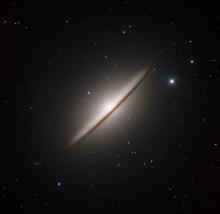Listen to today's episode of StarDate on the web the same day it airs in high-quality streaming audio without any extra ads or announcements. Choose a $8 one-month pass, or listen every day for a year for just $30.
You are here
Busy Merger
A galaxy merger can be messy. Stars in the two galaxies are stirred up like chocolate chips mixed into a batch of cookie dough. Some stars are tossed out of the galaxies, while gas clouds slam together to give birth to new stars. And the central black holes of the two galaxies spiral together, setting off their own fireworks when they merge.
Such a merger appears to be underway in a system in Ursa Major, the great bear, which is high in the north on May evenings. The black holes are a few thousand light-years apart, so any merger is still millions of years away. But they reveal something about the individual galaxies in the merger.
The system is known as J1126+2944, for its coordinates in the sky. One of its black holes appears to be hundreds of times more massive than the other. That suggests that this isn’t a merger of equals. Instead, one galaxy may be big and heavy, like our own galaxy, the Milky Way. The other may be a dwarf galaxy, only a fraction the size of its partner.
If so, then its center may contain an intermediate-mass black hole — one that’s perhaps tens of thousands of times the mass of the Sun. So far, there’s evidence of only a handful of these black holes. It’s possible that they’re the “seeds” from which supermassive black holes grow — the monsters that inhabit the hearts of big galaxies. In fact, its merger with the other black hole will make that black hole even bigger — adding to the heft of a monster black hole.
Script by Damond Benningfield






